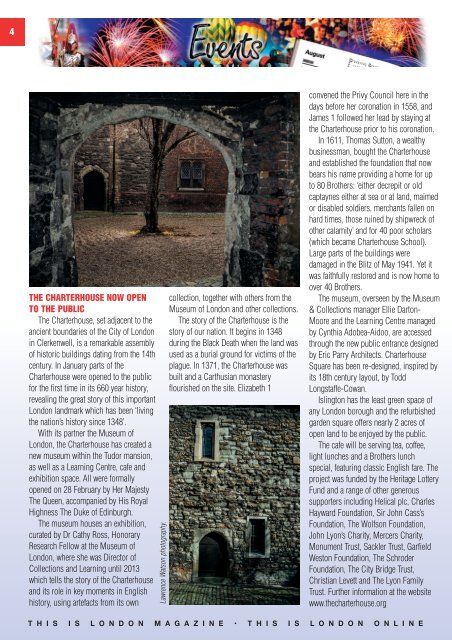til_24-3-17
Create successful ePaper yourself
Turn your PDF publications into a flip-book with our unique Google optimized e-Paper software.
4<br />
THE CHARTERHOUSE NOW OPEN<br />
TO THE PUBLIC<br />
The Charterhouse, set adjacent to the<br />
ancient boundaries of the City of London<br />
in Clerkenwell, is a remarkable assembly<br />
of historic buildings dating from the 14th<br />
century. In January parts of the<br />
Charterhouse were opened to the public<br />
for the first time in its 660 year history,<br />
revealing the great story of this important<br />
London landmark which has been ‘living<br />
the nation’s history since 1348’.<br />
With its partner the Museum of<br />
London, the Charterhouse has created a<br />
new museum within the Tudor mansion,<br />
as well as a Learning Centre, cafe and<br />
exhibition space. All were formally<br />
opened on 28 February by Her Majesty<br />
The Queen, accompanied by His Royal<br />
Highness The Duke of Edinburgh.<br />
The museum houses an exhibition,<br />
curated by Dr Cathy Ross, Honorary<br />
Research Fellow at the Museum of<br />
London, where she was Director of<br />
Collections and Learning un<strong>til</strong> 2013<br />
which tells the story of the Charterhouse<br />
and its role in key moments in English<br />
history, using artefacts from its own<br />
Lawrence Watson photography.<br />
collection, together with others from the<br />
Museum of London and other collections.<br />
The story of the Charterhouse is the<br />
story of our nation. It begins in 1348<br />
during the Black Death when the land was<br />
used as a burial ground for victims of the<br />
plague. In 1371, the Charterhouse was<br />
built and a Carthusian monastery<br />
flourished on the site. Elizabeth 1<br />
convened the Privy Council here in the<br />
days before her coronation in 1558, and<br />
James 1 followed her lead by staying at<br />
the Charterhouse prior to his coronation.<br />
In 1611, Thomas Sutton, a wealthy<br />
businessman, bought the Charterhouse<br />
and established the foundation that now<br />
bears his name providing a home for up<br />
to 80 Brothers: ‘either decrepit or old<br />
captaynes either at sea or at land, maimed<br />
or disabled soldiers, merchants fallen on<br />
hard times, those ruined by shipwreck of<br />
other calamity’ and for 40 poor scholars<br />
(which became Charterhouse School).<br />
Large parts of the buildings were<br />
damaged in the Blitz of May 1941. Yet it<br />
was faithfully restored and is now home to<br />
over 40 Brothers.<br />
The museum, overseen by the Museum<br />
& Collections manager Ellie Darton-<br />
Moore and the Learning Centre managed<br />
by Cynthia Adobea-Aidoo, are accessed<br />
through the new public entrance designed<br />
by Eric Parry Architects. Charterhouse<br />
Square has been re-designed, inspired by<br />
its 18th century layout, by Todd<br />
Longstaffe-Cowan.<br />
Islington has the least green space of<br />
any London borough and the refurbished<br />
garden square offers nearly 2 acres of<br />
open land to be enjoyed by the public.<br />
The cafe will be serving tea, coffee,<br />
light lunches and a Brothers lunch<br />
special, featuring classic English fare. The<br />
project was funded by the Heritage Lottery<br />
Fund and a range of other generous<br />
supporters including Helical plc, Charles<br />
Hayward Foundation, Sir John Cass’s<br />
Foundation, The Wolfson Foundation,<br />
John Lyon’s Charity, Mercers Charity,<br />
Monument Trust, Sackler Trust, Garfield<br />
Weston Foundation, The Schroder<br />
Foundation, The City Bridge Trust,<br />
Christian Levett and The Lyon Family<br />
Trust. Further information at the website<br />
www.thecharterhouse.org<br />
t h i s i s l o n d o n m a g a z i n e • t h i s i s l o n d o n o n l i n e

















